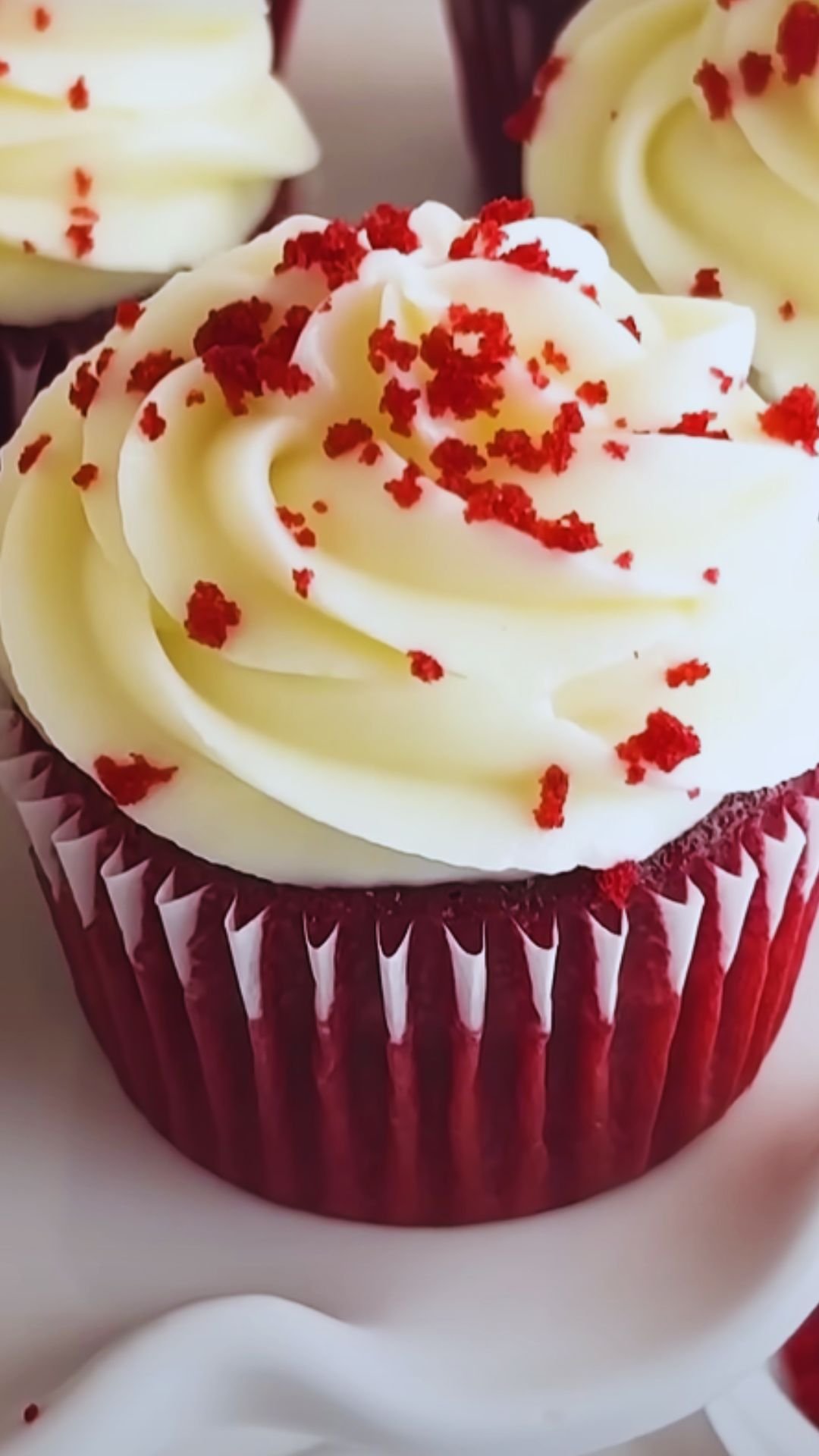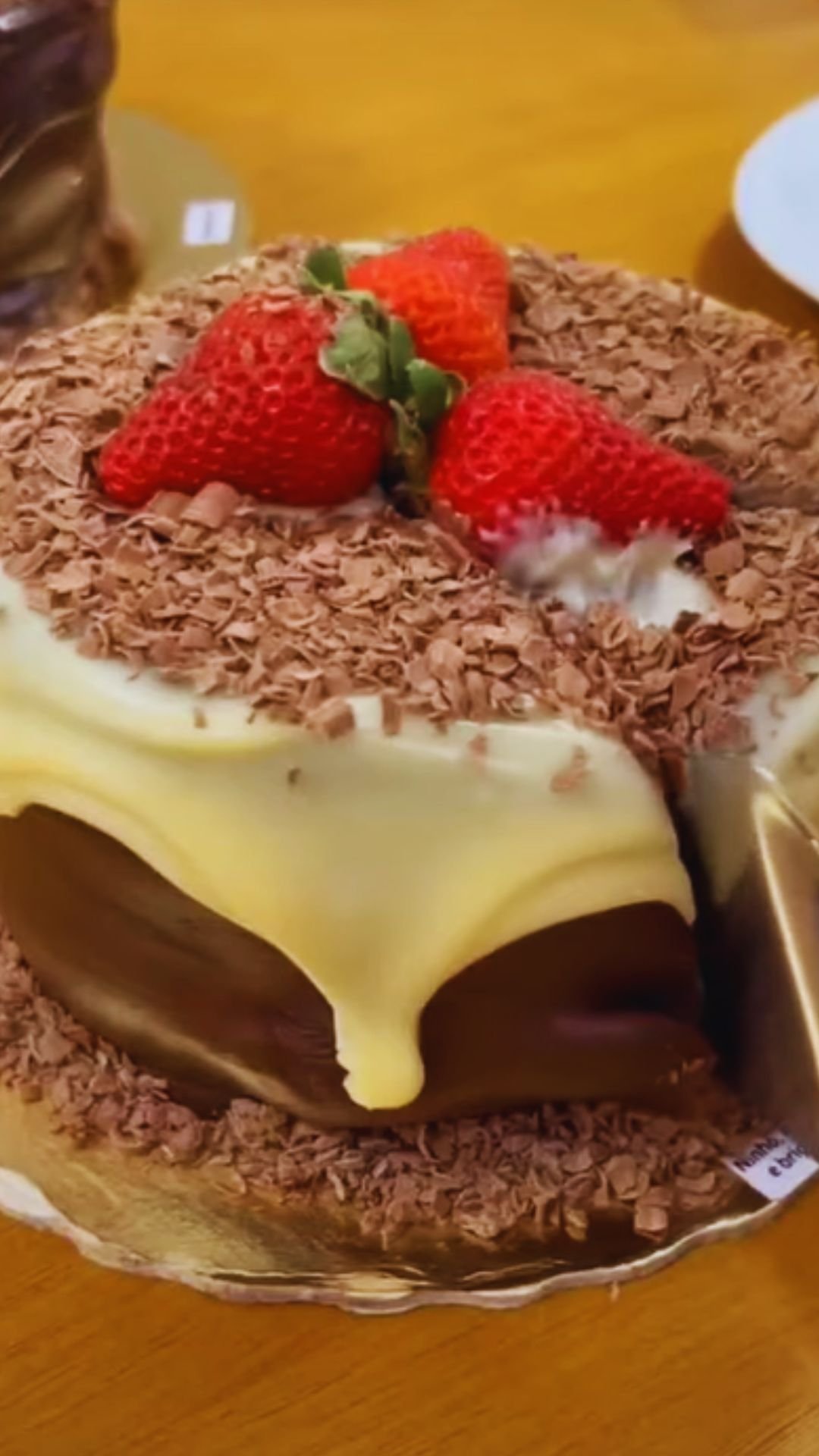Have you ever walked into a bakery, spotted those vibrant red velvet treats, and felt your heart skip a beat? There’s something magical about that rich crimson color paired with the subtle chocolate flavor that makes red velvet irresistible. Today, I’m thrilled to share one of my favorite culinary experiments: Red Velvet Bagels!
These aren’t your ordinary bagels. They’re festive, eye-catching, and guaranteed to be the star of any celebration breakfast or brunch. I’ve spent months perfecting this recipe, balancing the cocoa flavor, achieving that signature red velvet color, and ensuring the perfect chewy bagel texture.
Why Red Velvet Bagels Are Perfect for Celebrations
When I first created these bagels for my sister’s birthday breakfast, I had no idea they would become our family’s most requested special occasion treat. The vibrant red color makes them naturally festive, while the slight cocoa flavor elevates them above ordinary bagels.
Red velvet bagels work wonderfully for:
- Valentine’s Day breakfasts
- Christmas morning
- Birthday celebrations
- Anniversary brunches
- Holiday gift baskets
- Graduation parties
The combination of their striking appearance and delicious flavor creates an instant celebratory atmosphere. Plus, imagine the looks on your guests’ faces when you serve these instead of traditional bagels!
The History Behind Red Velvet
Before diving into our recipe, let’s take a moment to appreciate red velvet’s fascinating history. Contrary to popular belief, red velvet wasn’t created by the Waldorf Astoria hotel in the 1920s (though they certainly helped popularize it).
Red velvet cake dates back to the Victorian era when bakers used non-Dutch processed cocoa powder, which contained anthocyanins that would react with acidic ingredients to produce a reddish hue. During World War II, bakers began using beet juice or red food coloring to enhance this color, creating the vibrant red we associate with red velvet today.
I’ve incorporated these historical elements into my bagel recipe, using both cocoa powder and food coloring to achieve that perfect red velvet look and taste.
Essential Ingredients for Perfect Red Velvet Bagels
The secret to exceptional red velvet bagels lies in understanding each ingredient’s purpose:
Bread flour : Provides the high protein content necessary for chewy bagels with good structure. All-purpose flour simply won’t give you that authentic bagel texture.
Cocoa powder : Contributes the subtle chocolate flavor characteristic of red velvet. I recommend using natural (non-Dutch processed) cocoa powder for the most authentic taste.
Red food coloring : Creates the vibrant color. I prefer gel food coloring as it provides intense color without adding excess liquid to the dough.
Brown sugar : Adds moisture and a subtle molasses flavor that complements the cocoa beautifully.
Buttermilk : Provides tenderness and tanginess while helping activate the baking soda.
Baking soda : Works with the acidic buttermilk to create a subtle rise and that characteristic red velvet flavor profile.
White vinegar : Enhances the red color by reacting with the cocoa powder and helps create that distinctive red velvet tang.
Equipment You’ll Need
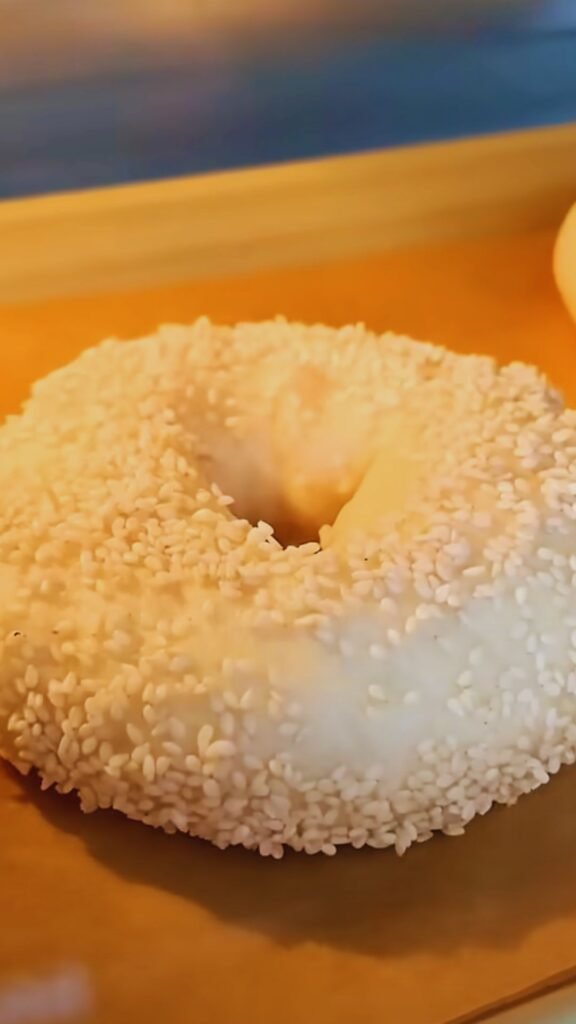
Before starting, gather these essential tools:
- Kitchen scale (for precise measurements)
- Stand mixer with dough hook (or strong arms for kneading!)
- Large mixing bowl
- Small saucepan (for boiling water bath)
- Slotted spoon or spider strainer
- Baking sheets
- Parchment paper
- Cooling rack
- Sharp knife or kitchen scissors (for slashing)
- Thermometer (to check water temperature)
Having everything prepared before you begin will make the bagel-making process much smoother.
The Complete Red Velvet Bagel Recipe
Now, let’s get to the star of the show—the recipe itself!
Ingredients
For the Bagels:
- 500g bread flour (approximately 4 cups)
- 15g kosher salt (approximately 1 tablespoon)
- 12g granulated sugar (approximately 1 tablespoon)
- 15g brown sugar (approximately 1 tablespoon)
- 10g instant yeast (approximately 1 tablespoon)
- 285ml warm water (approximately 1¼ cups)
- 2 tablespoons buttermilk
- 3 tablespoons natural cocoa powder
- 1 teaspoon baking soda
- 1 tablespoon red gel food coloring
- 1 teaspoon white vinegar
For the Water Bath:
- 2 quarts water
- 2 tablespoons honey or barley malt syrup
- 1 tablespoon baking soda
For Topping (Optional):
- White chocolate chips
- Cream cheese for serving
Instructions
- Prepare the dry ingredients: In the bowl of your stand mixer, whisk together the bread flour, salt, granulated sugar, brown sugar, and instant yeast.
- Mix the wet ingredients: In a separate bowl, combine the warm water (about 105°F/40°C), buttermilk, cocoa powder, baking soda, red food coloring, and white vinegar. Stir until the cocoa powder is dissolved.
- Form the dough: Slowly add the wet ingredients to the dry ingredients while mixing on low speed with the dough hook attachment. Mix for about 2 minutes until everything is incorporated.
- Knead the dough: Increase the speed to medium-low and knead for 7-8 minutes. The dough should be smooth, elastic, and slightly tacky but not sticky. It should pass the window pane test (when stretched, it should form a thin membrane before tearing).
- First rise: Transfer the dough to a lightly oiled bowl, cover with plastic wrap or a damp cloth, and let rise in a warm place for 1 hour, or until nearly doubled in size.
- Shape the bagels: Divide the dough into 8 equal pieces (about 100-110g each). To shape each bagel, roll the piece into a tight ball, then press your thumb through the center to create a hole. Gently stretch the hole to about 2 inches in diameter, being careful to maintain an even thickness all around.
- Second rise: Place the shaped bagels on a parchment-lined baking sheet, cover loosely with a damp towel, and let rest for 30 minutes.
- Preheat the oven: Set your oven to 425°F (220°C).
- Prepare the water bath: In a wide pot, bring the water, honey or barley malt syrup, and baking soda to a gentle boil.
- Boil the bagels: Carefully lower 2-3 bagels into the simmering water bath. Boil for 1 minute on each side. Remove with a slotted spoon, allowing excess water to drip off, and return to the parchment-lined baking sheet.
- Add toppings (optional): If using white chocolate chips, sprinkle them on top of the bagels immediately after boiling while they’re still wet.
- Bake: Bake for 20-22 minutes, or until the bagels are firm and sound hollow when tapped on the bottom. They won’t brown as much as traditional bagels due to the cocoa powder, so don’t rely on color alone to determine doneness.
- Cool: Transfer the bagels to a wire rack and let cool for at least 20 minutes before slicing.
Nutritional Information
| Nutrient | Amount per Bagel |
|---|---|
| Calories | 235 |
| Total Fat | 1.5g |
| Saturated Fat | 0.3g |
| Cholesterol | 1mg |
| Sodium | 750mg |
| Total Carbohydrate | 47g |
| Dietary Fiber | 2g |
| Sugars | 5g |
| Protein | 8g |
| Calcium | 20mg |
| Iron | 3mg |
*Note: Nutritional values are approximate and do not include toppings or spreads.
Troubleshooting Common Issues
Even experienced bakers encounter challenges. Here are solutions to common red velvet bagel problems:
Bagels Don’t Rise Properly
- Problem: Yeast might be inactive or the environment too cold.
- Solution: Ensure your yeast is fresh and active. If your kitchen is cold, create a warm environment by preheating your oven to its lowest setting, turning it off, and placing the covered dough inside.
Bagels Are Too Dense
- Problem: Insufficient kneading or rising time.
- Solution: Knead until the dough passes the window pane test. Allow enough time for both rises, especially in cooler weather.
Color Is Too Brown Rather Than Red
- Problem: Too much cocoa powder or not enough food coloring.
- Solution: Balance is key. Use natural cocoa powder (not Dutch-processed) and adjust the amount of food coloring as needed.
Holes Close Up During Baking
- Problem: Holes weren’t stretched enough or dough was overproofed.
- Solution: Make the holes larger than you think necessary (about 2 inches) as they will shrink during boiling and baking.
Bagels Are Wrinkly After Boiling
- Problem: Water bath temperature was too high.
- Solution: Maintain a gentle simmer, not a rolling boil.
Creative Serving Suggestions
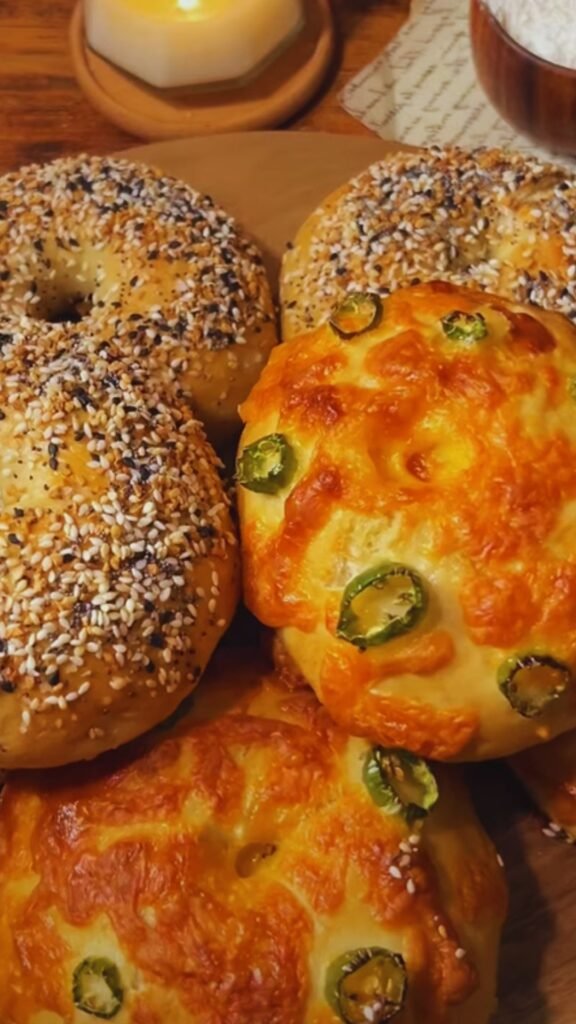
Red velvet bagels are versatile and pair beautifully with various toppings:
Sweet Options:
- Cream cheese frosting (traditional red velvet pairing)
- White chocolate cream cheese spread
- Vanilla bean mascarpone
- Butter and honey
- Nutella or chocolate hazelnut spread
Savory Options:
- Plain cream cheese with fresh berries
- Herb-infused cream cheese
- Smoked salmon with dill cream cheese (the color contrast is stunning!)
- Avocado with a sprinkle of everything bagel seasoning
Celebration Spreads: For special occasions, I love creating a bagel board with multiple spreads, fruits, nuts, and toppings that allow guests to customize their bagels.
Storage and Freezing Tips
To maintain freshness:
Short-term Storage (1-2 days): Store cooled bagels in a paper bag at room temperature. The paper allows them to breathe while maintaining a crisp exterior.
Medium-term Storage (3-5 days): Keep in an airtight container with a slightly damp paper towel to maintain moisture. Refresh by toasting before serving.
Freezing (up to 3 months):
- Allow bagels to cool completely
- Slice if desired (makes toasting from frozen easier)
- Wrap individually in plastic wrap
- Place wrapped bagels in a freezer bag, removing as much air as possible
- Label with the date
- To thaw, leave at room temperature for 30 minutes or toast directly from frozen
Making Mini Red Velvet Bagels
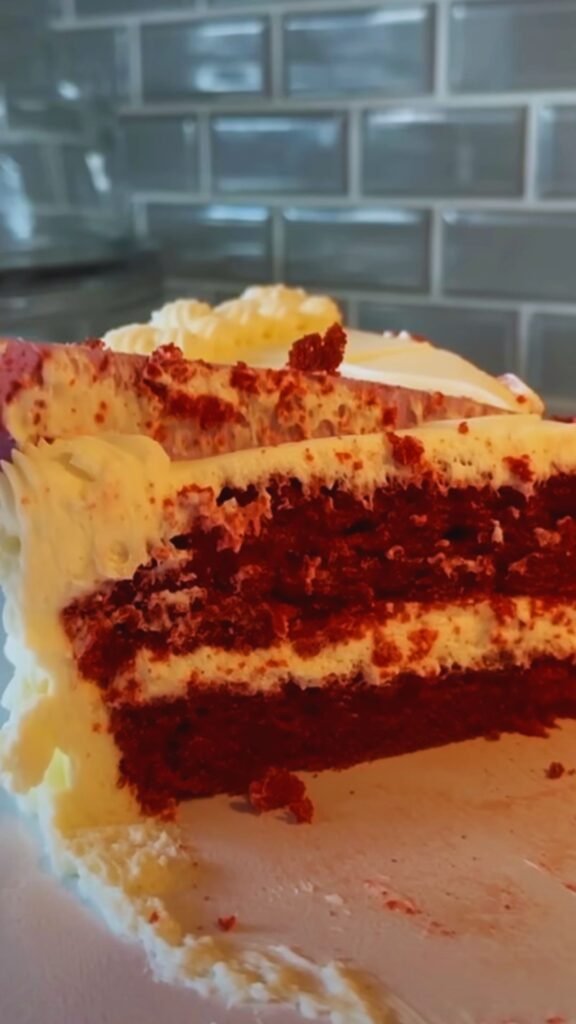
For celebration platters or kid-friendly portions, try making mini versions:
- Divide the dough into 16 equal pieces instead of 8
- Shape as directed, making slightly smaller holes
- Reduce the boiling time to 45 seconds per side
- Bake for 15-18 minutes instead of 20-22
These mini bagels are perfect for celebration brunches, children’s parties, or when you want to offer variety without large portions.
Frequently Asked Questions
Can I use all-purpose flour instead of bread flour? While technically possible, the results won’t be authentic bagels. Bread flour’s higher protein content (12-14%) creates the chewy texture bagels are known for. All-purpose flour (10-12% protein) will produce softer, less chewy results.
How can I make these bagels without artificial food coloring? You can use beet powder or beet juice as a natural alternative. Mix 3 tablespoons of beet powder with the dry ingredients or replace 2 tablespoons of the water with beet juice. The color won’t be as vibrant but will have a natural reddish hue.
Can I make the dough ahead of time? Yes! After shaping the bagels, place them on a parchment-lined tray, cover tightly with plastic wrap, and refrigerate overnight (up to 24 hours). Remove from the refrigerator 30 minutes before boiling.
Why do we boil bagels before baking? Boiling sets the crust before baking, resulting in the characteristic chewy interior and shiny exterior. The honey or malt in the water bath adds flavor and helps with browning.
How can I tell when the bagels are done baking? Since red velvet bagels won’t brown as obviously as plain bagels, look for a firm surface and tap the bottom—it should sound hollow. The internal temperature should reach about 190°F (88°C).
Can I make these gluten-free? While possible, gluten-free bagels require significant recipe modifications. I recommend using a specialized gluten-free bagel recipe as your base, then adding the cocoa powder, food coloring, and other red velvet elements.
Creating a Celebration Bagel Brunch
These red velvet bagels make a stunning centerpiece for a celebration brunch. Here’s how I create a memorable spread:
- Prepare 1-2 days ahead: Bagels taste better after the flavors have time to develop
- Create a beautiful display: Arrange whole and halved bagels on a wooden board or tiered stand
- Offer variety: Include both sweet and savory toppings in small bowls
- Add complementary items: Fresh fruit, smoked salmon, capers, sliced vegetables
- Beverage pairings: Coffee, tea, orange juice, sparkling water with berries
- Festive touches: Fresh flowers, color-coordinated napkins, special plates
A red velvet bagel brunch works wonderfully for baby showers, bridal celebrations, birthdays, or holiday gatherings.
Final Thoughts on Red Velvet Bagels
Creating these red velvet bagels brings together traditional bagel-making techniques with the beloved flavor profile of red velvet cake. While they require some time and patience, the results are well worth the effort.
What makes these bagels special isn’t just their striking appearance but the care that goes into making them. There’s something deeply satisfying about transforming simple ingredients into something so beautiful and delicious.
I hope these bagels bring as much joy to your celebrations as they have to mine. Whether you’re making them for a special someone or simply treating yourself, they’re sure to make any day feel like a celebration.
Happy baking!
